Vol 4 No. 6 TROPIC LIGHTNING NEWS February 10, 1969
Index
Vietnamese III
Corps Commander
Awards Gallantry Cross To Division
CU CHI On Tuesday, January 28,
1969, Lieutenant General Do Cao Tri, Vietnamese commander of the III Corps
Tactical Zone, presented the Vietnamese Cross of Gallantry with Palm to the men
of the 25th Infantry Division. Tropic Lightning commander, Major General
Ellis W. Williamson, accepted the award on behalf of the men of the 25th.
The Cross is a tribute to the men who served with the Lightning
Division between December, 1965, to August, 1968. Their efforts on the
battlefield and the intense civic action programs were cited as major
contributions to the preservation of freedom in the Republic of Vietnam.
Generals Tri and Williamson trooped the line while a formation of
division aircraft flew overhead. The citation was read in Vietnamese and
English. While General Williamson held the division colors, General Tri
attached the Cross of Gallantry streamer to the guidon.
After the streamer was attached to the division colors, General Tri
addressed the men of the 25th:
“Your sacrifices, your dedication to duty and your sense of
responsibility have helped safeguard freedom and democracy in this part of the
world.”
General Williamson then spoke. The commander of the 25th paid
tribute to Major General F. K. Mearns who commanded the division for a “major
portion of the time for which it is being cited.”
General Williamson likened the struggle in Vietnam to the United
States fight for freedom during the American Revolution. Soldiers came
from over the sea to help us win and maintain our own freedom,” he said.
“So, in effect, we are repaying a debt to history.”
To point out that the Army of the Republic of Vietnam and its
allies are winning the struggle, General Williamson concluded his remarks by
issuing a challenge to “any Viet Cong, any North Vietnamese unit anywhere in
South Vietnam to conduct a public ceremony such as this.”
Present at the ceremony were Lieutenant General Walter T. Kerwin,
CG of II Field Force; Lieutenant General Frank T. Mildren, Deputy CG USARV:
Major General Mearns; Brigadier General Donald D. Dunlop, former assistant
division commander for maneuver; Brigadier General Glen C. Long, Jr.,
former assistant division commander for maneuver and Brigadier General Carleton
Preer, Jr., assistant division commander for maneuver.
Brigadier General Edwin F. Black was commander of the troops.
Battalions in the division were represented at the award ceremony, held in Cu
Chi base camp’s Lightning Bowl, by their commanders.
Tropic Lightning aircraft, armor and artillery were on display at
the ceremony. Featured in the aircraft display was the new Bronco (OVIO)
Light observation airplane. The Sheridan tank, the latest armor piece in
Vietnam, was also on display.
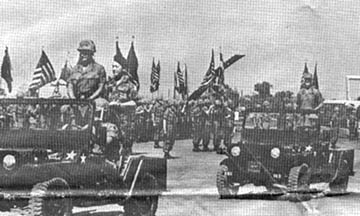 |
REVIEWING TROOPS – Lieutenant General Do Cao Tri, Vietnamese commander of the III Corps Tactical Zone, is escorted by Brigadier General Edwin F. Black, the assistant division commander for support. Major General Ellis W. Williamson, 25th Division commanding general rides in the following vehicle. |
Triple Deuce, Arty Blast VC
Ambushers
By SP4 John Caldwell
DAU TIENG - An estimated reinforced
enemy battalion attempted ambushes on two convoys five and nine miles of Dau
Tieng on Jan. 14. This marked the second and third ambushes in less than a
month.
Once again, mechanized infantrymen of the 2d Battalion
(Mechanized), 22d Infantry were on the scene in moments. The Battalion
supported by artillery fire, gunships and air strikes, killed 122 enemy soldiers
in the abortive ambushes.
The convoy from Cu Chi to the Tropic Lightning’s 3d Brigade base
camp 45 miles northwest of Saigon had just split off from the Tay Ninh convoy.
It was traveling along Route 239 near the Ben Cui Rubber Plantation. The
enemy’s ambush site was less than a mile from the spot where 73 enemy died in
December, also in an abortive ambush attempt.
“I guess Charlie doesn’t learn too fast. Each time he
tries this we come out way on top,” said Staff Sergeant William Kunkel of
Alpha Company, Triple Deuce, from Chicago.
As enemy RPG rocket grenades and small arms fire flew everywhere,
Alpha Company roared up aboard their armored personnel carriers, spewing .50
caliber machinegun fire onto the enemy positions.
The company made three assaults, inflicting heavy casualties on the
fleeing enemy.
Captain David Crocker of Old Mystic, Conn., Alpha commander,
praised the swift reactions of his company and of a Triple Deuce Combined
Reconnaissance Patrol, who hurried up to reinforce.
“Your men were here so fast that they must have come by air,” a
grateful trucker told Crocker.
Crocker’s command track was hit and caught fire, but no one was
hurt. His radio operator, Specialist 4 Gordon C. Olson of Portland, Ore.,
stayed with the disabled vehicle and kept up communications as the rest of the
infantrymen fought on.
Olson successfully called in three dustoff helicopters to evacuate
wounded. He also directed Air Force jets and eight strikes by Cobra
helicopter gunships to within 50 meters of friendly lines.
“He did a whale of a job,” said Crocker.
Meanwhile division artillery (Continued on Back
Page)
| EVERY WEEK IS SAFETY WEEK in the 25th Infantry Division. Enough emphasis cannot be placed on such things as weapons safety, good driving habits, proper handling of tools, alertness and keen awareness of the dangers that may exist as we perform our jobs each day. Always remember - THINK SAFETY! |
| GENERAL TRI - presents the Vietnamese Cross Of Gallantry To Gen. Williamson. (PHOTO BY SP5 LARRY WEIST) | 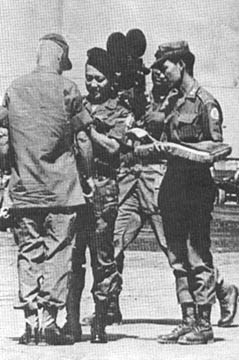 |
Page 2 TROPIC LIGHTNING NEWS February 10, 1969
Decorated
| BRONZE STAR
(HEROISM) |
|
| MAJ Gerard Delvin,
HHC, 3d Bn, 22d Inf 1LT Gary W. Barnes, A Trp, 3d Sqdn, 4th Cav 1LT James Carper, HHC, 3d Bn, 22d Inf SGM Robert Adams, HHC, 3d Bn, 22d Inf SSG Adam M Flores, B Btry, 7th Bn, 11th Arty SSG Joseph LeCount, HHC, 3d Bn, 22d Inf SGT David Guider, Co A, 1st Bn, 5th Inf SP4 George A. Sharp, 25th MP Co SP4 Lawrene R. Demaria, 25th MP Co SP4 Carl R. Duncan, Jr, 25th MP Co SP4 Henry H. Bernshausen, 25th MP Co SP4 David Chedester, HHC, 3d Bn, 22d Inf CPL Jimmie D. Dodson, B Trp, 3d Sqdn, 4th Cav PFC Leroy Hatcher, C Btry, 7th Bn, 11th Arty PFC David Duhe, Co A, 1st Bn, 5th Inf PFC Charles Sheldon, Co B, 3d Bn, 22d Inf PFC William V. Anello, B Btry, 7th Bn, 11th Arty PFC Tapelci Pusi, Co B, 3d Bn, 22d Inf PFC Rufus Small, Co A, 1st Bn, 5th Inf PFC Gayle G. Schumacher, Co C, 4th Bn, 23d Inf SP4 Tommy Sandoval, Co C, 4th Bn, 23d Inf SP4 Curtis C Foimnsbee, Co B, 4th Bn, 9th Inf SP4 Jon J Teschner, Co B, 1st Bn, 5th Inf SP4 Charles Flannery, Co B, 1st Bn, 5th Inf SP4 Douglas K Elias, Co A, 2d Bn, 14th Inf SP4 James Scott, Co B, 3d Bn, 22d Inf SP4 Paul M. Bogosian, HHC, 1st Bn, 5th Inf SP4 Leroy J. Taylor, Co D, 4th Bn, 9th Inf SP4 Kenneth R. Nichols, Co C, 4th Bn, 23d Inf SP4 Jack W. Ruley, Co A, 1st Bn, 5th Inf SP4 Frank Sposato Jr, Co B, 4th Bn, 9th Inf SP4 Daniel D. Motozzi, Co A, 2d Bn, 34th Armor SP4 Engle Smith, Co C, 4th Bn, 23d Inf SP4 Charles L. Wagner, Co A, 4th Bn, 9th Inf |
SP4 Charles W.
Ellis, Co C, 4th Bn, 23d Inf SP4 Robert Misevich, HHC, 2d Bn, 22d Inf SP4 Marvin E. Branch, Co C, 4th Bn, 23d Inf SP4 Gale J. Nash, Co A, 1st Bn, 5th Inf SP4 Daniel W. Datzko, Co A, 1st Bn, 5th Inf SP4 Robert Misevich, HHC, 2d Bn, 22d Inf SP4 Vasco R. McDonald, Co A, 4th Bn, 9th Inf PFC Dennis L. Wade, Co C, 4th Bn, 23d Inf PFC Ronald L. Hayes, Co B, 2d Bn, 14th Inf PFC Dale Nowakowski, Co B, 3d Bn, 22d Inf PFC James H. Tyson, Co B, 1st Bn, 5th Inf PFC Leonard R. Summerhill, Co C, 4th Bn, 23d Inf PFC Timothy M. Gresh, Co C, 4th Bn, 23d Inf PFC Edward Grochola, Jr, Co C, 4th Bn, 23d Inf SP4 Richard Woodall, C Co, 4th Bn, 9th Inf SP4 Robert Timko, D Co, 2d Bn, 14th Inf PFC Sherrell Shelton, B Co, 1st Bn, 27th Inf PFC Wayne Smith, A Co, 1st Bn, 27th Inf PFC William Haney, A Co, 1st Bn, 27th Inf PFC Robert Gilbertson, B Co, 1st Bn, 27th Inf PFC Donald Getty, B Co, 1st Bn, 27th Inf PFC Robert Jodal, B Co, 1st Bn, 27th Inf PFC Roger Adams, C Co, 4th Bn, 23d Inf PFC Richard Molina, A Co, 2d Bn, 22d Inf PFC Peter Hernandez, A Co, 1st Bn, 27th Inf PFC Gary Battles, A Co, 2d Bn, 22d Inf PFC Ronald Latkovic, B Co, 25th S&T Bn PFC Leland Price, A Co, 2d Bn, 22d Inf PFC Alvin Stewart, D Co, 65th Engr Bn PFC Paul Benoit, HHC, 4th Bn, 23d Inf PFC Bobby Myers, A Co, 2d Bn, 27th Inf PFC Ferendo Garza, D Co, 2d Bn, 27th Inf PFC Jesse Bowlson, A Co, 1st Bn, 5th Inf PFC John Mondragon, A Co, 1st Bn, 5th Inf |
Know Income Tax Regulations
While You Serve In Vietnam
U.S. Armed Forces personnel in Vietnam and other individuals,
such as Red Cross workers, Department of the Army civilians, industrial
technicians, and accredited correspondents who support the Armed Forces, have an
automatic extension of time to file their federal income tax returns. Such
individuals are given up to 180 days after they return from the combat zone to
file.
If an individual is hospitalized outside the US as a result of an
injury incurred in the combat zone (even though the hospitalization is not in
the combat zone), the return is due 180 days after release from the hospital.
These extensions apply to the filing of joint returns by a member
and his spouse, but do not apply to the spouse if she chooses to file a separate
return. To be eligible for the extension, individuals must be in the
combat zone before the ordinary date for filing 1968 returns, which, of course,
is 15 April 1969.
It is important that a statement showing the inclusive dates of
combat zone active service, or continuous hospitalization outside the US as a
result of a combat zone injury, be attached to postponed returns when filed and
to any delinquency notices being returned by reason of the postponements.
For example: “I served on active duty as a member of the Armed
Forces of the US in the Vietnam Combat Zone from (date, month, year) until
(date, month, year). The postponed due date for filing this return as
authorized by virtue of section 7508 of the Internal Revenue Code is (date,
month, year).”
If you are due a refund on your 1968 taxes, it is to your benefit
to file your return as soon as possible after you receive your 1968 W-2 Form.
In this way, your refund could be earning interest in a savings account after
receipt.
All compensation received by warrant officers and enlisted men for
active service in Vietnam and adjacent waters is exempt from federal income tax
and need not be reported.
Personnel hospitalized at any place outside the US as a result of
wounds, disease, or injury incurred in Vietnam or its adjacent waters are also
entitled to the exclusions. Commissioned officers are entitled to tax
exemption only on the first $500 of each month’s pay.
The exclusions apply for the entire month during any portion of
which the individual served in Vietnam, even if it is only a fraction of a day.
The block entitled “Wages paid subject to withholding in 1968” of your W-2
Form normally show wages after the above exclusions have been figured. You
should contact the Finance Officer if the W-2 is wrong.
An item of concern to many - any interest you receive as a result
of money held in the Uniform Servicemen’s Savings Deposit Program (10 per cent
interest program) is not taxable until the year of actual receipt.
Usually, this is after you have returned to CONUS.
Treat People Like People
If you are in a field unit, always try to remember that a good deal
of the time you may be on somebody’s private property, and possibly doing it
some harm.
If the man who owns the rice paddy you are in doesn’t seem
particularly happy to see you there, try to picture how an Iowa farmer would
feel, seeing your company marching through his corn field.
As much as possible, try to respect the property and possessions of
others. Remember that everything you see in the field doesn’t belong to
you. It probably belongs to a man whose living depends on how much rice he can
produce and either use for himself or market.
You’re walking on what he makes his living with - the rice
growing under your boot.
Marijuana Turns Your Pals
Into Deadliest Of Enemies
You are one soldier among 500,000 in Vietnam. You share many
of the same daily problems as the man in the Delta and as the man in the
Highlands. You face the same conditions and you are concerned with the
same thing - getting home after a tour in Vietnam.
Marijuana can change a lot of your plans for you.
Little is known about the long-term effects of marijuana use.
In its mildest form marijuana does not appear to be physically dangerous.
However, the effects of marijuana, caused by chemical ingredients called
tetra-hydro-cannabinols (THC), vary with the individual.
A given dosage of THC may have no apparent ill effects on one
person but may have pronounced effects on another. You cannot be certain
that even a mild form or dose of marijuana is totally safe for you.
The possession, use or sale of marijuana is a violation of the
Uniform Code of Military Justice and is punishable by courts-martial and up to
five years in prison.
Administratively, the U. S. government may also impose and collect
a tax of $100 for each ounce or fraction of an ounce possessed.
Any man with common sense knows that used properly, drugs
contribute to life. Used improperly, they bring harm to the user and those
who must rely on him.
In the military, a drug abuser is a threat to the life and to the
morale of his comrades.
As likeable an individual as he may be, in a combat zone he is
truly more your enemy than your friend. Back in the States, he will be a
drag on his friends, his family and his community.”
It is very difficult to admire such a man. It would be tragic
to become one.
The TROPIC LIGHTNING NEWS is an authorized publication of the 25th Infantry Division. It is published weekly for all division units in the Republic of Vietnam by the Information Office, 25th Infantry Division, APO San Francisco 96225. Army News Features, Army Photo Features, Armed Forces Press Service and Armed Forces News Bureau material are used. Views and opinions expressed are not necessarily those of the Department of the Army. Printed in Tokyo, Japan, by Pacific Stars and Stripes.
MG Ellis W. Williamson . . . . Commanding General
MAJ Andrew J. Sullivan . . . Information Officer
2LT Don A. Eriksson . . . . . . Officer-in-Charge
SP4 Stephen Lochen . . . . . . Editor
SP4 Jim Brayer . . . . . . . . . . . . Assistant Editor
SP4 Robert C. Imler . . . . . . . Production Supervisor
Page 3 TROPIC LIGHTNING NEWS February 10, 1969
Probing Warriors Detain Nine
Uncover Cong Mortar Pits
CU CHI - Warriors from the 2d
Brigade’s 2d Battalion, 12th Infantry, while sweeping northwest of Cu Chi near
Trang Bang detained nine armed suspects during two days of operations.
“We were moving through a dense hedgerow area when the company
commander spotted a piece of strangely high ground,” said Delta Company RTO
Specialist 4 Dennis L. Rusch of Lake Park, Iowa.
Platoon Sergeant Ronald Dusch, Colorado Springs, Colo. moved in
quickly and began probing with a bayonet. In the center of the bamboo
thicket his probe struck home. “I found a small buried trap door,”
said Dusch. “I eased it open and two hands popped up,” he added.
He guessed that more than one enemy must be hiding in the dark
underground room. An ARVN interpreter was called to shout into the hole.
“We have found you. Come out now. We are going to throw hand
grenades into the hole,” he shouted.
“That got some action,” commented Delta’s CO Captain Paul F.
Allen, Orlando, Fla. “They couldn’t get out fast enough,” he added.
With the enemy soldiers extracted, a search of their hiding place
turned up a Chicom pistol, two AK-47 assault rifles and an AK-50 machine gun.
The following day, while searching another area of dense bamboo
hedgerows, lead elements of the Fire Brigade’s 2d Battalion, 12th Infantry,
rifle company discovered two carefully camouflaged enemy mortar pits.
“As soon as we got all-around security established, we began a
thorough search of the jungle around the pits,” said Allen.
“For the second time in two days Dusch found a hole full of
VC,” said First Lieutenant Jim Johnson, Ashland, Ky., who detained six enemy
plus a Communist-made hand gun and several photos and documents that made the
day a success.
“Basically, we’re learning how Charlie lives and operates in
this area and how he hides himself and his equipment. My people are
observant and they are finding these things, and I’m sure we’ll find
more,” said Allen.
 |
TROPIC LIGHTNING soldiers of Company C, 4th Battalion (Mechanized) 23d Infantry, cautiously check out a VC bunker complex. Fresh food was found throughout the complex. (PHOTO BY SP4 ROGER WELT) |
Regular PFC Misses His
Date With Destiny
Whether it was fate, destiny or just plain luck is not known.
But it is known that Private First Class Robert Vialpondo of Rocky Ford, Colo.
missed a date with death.
While on a reconnaissance-in-force mission northwest of Tay Ninh,
the 3d Battalion, 22d Infantry, came under intense small arms, automatic weapons
and RPG fire. Vialpondo returned fire with his M-60 machinegun.
“Suddenly there was a tremendous explosion and my head jerked
violently. My ears were ringing, and I was left dazed but recovered
quickly and continued firing,” said Vialpondo. Flying shrapnel from an
enemy RPG had penetrated his steel pot, ripping the side out of it. One
inch closer would have meant certain death.
Many Vietnam veterans have hair-raising stories to tell on their
return from the Nam. But Vialpondo doesn’t have to say a word. He
can just hold up his shattered headgear for all to see and sit back to watch the
expressions of his audience.
| CLOSE CALL - Tropic Lightning soldier Private First Class Robert Vialpondo of Rocky Ford, Colo., displays his torn steel pot which he was wearing when it was hit by shrapnel from an enemy RPG. (PHOTO BY SP4 DAVE DEMAURO) | 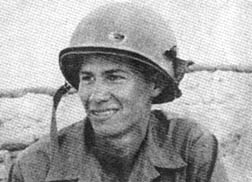 |
Dreadnought MEDCAPs Fighting
Their Own War
CU CHI - Few people think of a MEDCAP
(medical civic action program) team as a fighting unit. Tropic Lightning
soldiers, however, fight a war against disease that plagues the people of a
war-torn nation.
The 2d Battalion, 34th Armor’s civic action section with the aid
of battalion surgeon, Captain Herbert C. Pratt, of Santa Fe, Calif., conducts
MEDCAPs five afternoons a week.
According to Pratt, “the villagers were at first cautious about
the MEDCAPs. After repeated visits to the villages, they gained confidence
in us and our efforts were rewarded with the people coming to us.
“First came the children and then the adults.
“Once we are established in a village we generally treat about 75
patients in an afternoon; often it is more than one hundred.”
The majority of the medical aid teams’ treatment concerns
diseases of the skin, respiratory disorders and intestinal infections.
There are however a number of cases of tuberculosis, malaria and parasitic
diseases.
According to Pratt, MEDCAP effectiveness is limited by the lack of
medical laboratory facilities and the lack of patient follow-up. But the
co-operation with the provincial hospitals helps in the case of necessary
long-term medical aid and care.
Another phase of the MEDCAP program is the instruction of the
villagers in methods of disease prevention and the improvement of their health
facilities.
Individual soldiers in the field often help improve health
standards of the people. The men of the 2d Battalion, 34th Armor are a
good example of the help the GI can give. They have been collecting all
the extra soap, toothpaste and toilet articles they can at Fire Support Base
Crockett and surrounding areas for distribution by their ARVN counterparts to
the Vietnamese children in local schools.
This not only aids relations between the U.W. and ARVN forces, but
also promotes the work of the MEDCAP team.
As Sergeant First Class Billie Brown, Campbellsville, Ky., said,
“Better conditions for the Vietnamese will take a large prop out from under
the enemy’s propaganda.”
Is the plan working?
“I feel,” said Pratt, “that the MEDCAP program is a valuable
adjunct to the war effort. We have reached a time in which military might
alone is not the answer to bring the war to a reasonably acceptable end.
“It is for this reason that an increasing amount of time and
effort is now being directed toward such projects as the MEDCAP program in an
attempt to create a feeling of goodwill and confidence between the Vietnamese
people and the U.S. forces,” the doctor continued.
Tomahawks Use Scout Dogs
TAY NINH - While on a recent sweep ten
miles east of Tay Ninh City, Specialist Doningo Conlu, of Dededo village, Guam,
and his dog, Blackie, both members of the 46th Scout Dog Platoon, discovered a
base camp bunker complex.
The dog alerted toward the complex which was well concealed, about
ten meters off the main trail. The enemy had not used this base camp in
some time, but the dog was still able to alert on the position.
The 4th Battalion (Mechanized), 23d Infantry, is using the services
of the 46th Scout Dog Platoon while conducting sweeps throughout the Tay Ninh
area. The canine will not only alert on the enemy, but on any area that
has been occupied or visited by the foe.
Through the rice paddies, dense jungle, and the foliage that covers
much of the Mech’s operation area trudge the alert scout dog, Blackie, and his
handler Conlu.
Blackie and Conlu are specially trained in their unique role.
Months of strict training and working together have formed this successful
combination.
Conlu is pleased with the results he gets from Blackie.
“All those long hours of training and working together pay off when we locate
finds such as this one,” said Conlu at the scene of the hidden encampment.
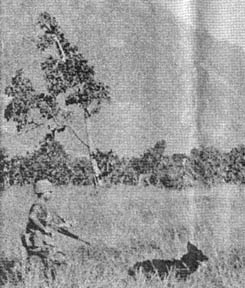 |
SCOUT DOG AT WORK – The 4th Battalion (Mechanized), 23d Infantry is using the services of the 46th Scout Dog Platoon. Pictured is Specialist 4 Doningo Conlu, of Dededo Village, Guam, and his dog, Blackie. In the background is the fabled mountain, Nui Ba Den. (PHOTO by SP4 ROGER WELT) |
Slick Angels
Bring Cheer
CU CHI - During the past holidays familiar refrains of Christmas
songs and carols drew curious gazes from the jungles and rice paddies near Cu
Chi.
Helicopters usually used for psychological operations against the
enemy traded recorded pleas for Chieu Hois for tapes of popular Christmas music
and holiday greetings.
Circling over fire support bases and night laagers in the 2d
Brigade area of operations, the music, marred only by the throbs of the Huey’s
rotors made the holiday season a bit brighter, prompting ‘thumbs-up’ signals
from the infantrymen on the ground. The ‘slicks’ were often greeted by
displays of red and green flares.
“It is good to see a machine of war responded to with smiles and
quiet appreciation,” said Specialist 4 Douglas A. McLouth of Shelby, Mich.,
from the 2d Brigade’s Fire Support Base Pershing, near Cu Chi.
Page 4 TROPIC LIGHTNING NEWS February 10, 1969
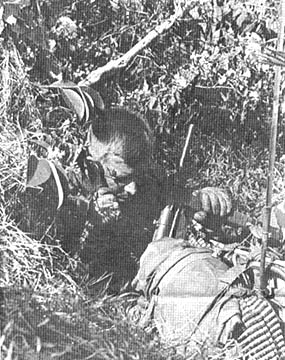 |
LRP TEAM LEADER First Lieutenant Arthur Tomascheck gets the okay from a scout team checking for possible enemy ambushes. The LRP team is part of the 50th Infantry. |
LRP’s Mission:
Seek Enemy
CU CHI - A group of perspiring men
walk onto Delta Troop flight line, their faces, blackened like show boat
minstrels. On their backs they carry all of the food and water they will
need for several days and nights plus enough ammunition to stand off an enemy
force five times their size.
Some of the packs weigh more than 80 pounds.
The scene is not unusual to the helicopter mechanics working on the
flight line. It is repeated often.
These are Long Range Patrols (LRPs) of F Company, 50th Infantry,
commanded by Captain Raymond L. Lawson, of Muskogee, Okla. The unit is attached
to the 3d Squadron, 4th Cavalry.
Their mission is a tough and daring one, but not an unusual one.
The men pit their ability to fight and survive against the enemy in his own
backyard.
This team is led by First Lieutenant Arthur Tomascheck, of
Allentown, Pa. His qualifications: three years of Special Forces training.
The assistant team leader is Staff Sergeant Richard Reader, of New
Castle, Pa. His qualifications: 16 months as an LRP team member. A
soldier who knows how to fight, Reader became a staff sergeant when he was 19
years old.
Next in line lumbers Specialist 4 Daniel Nate, of Woodbury, N.J.
He doesn’t move with jungle cat quickness of Tomascheck and Reader but walks
with powerful strides. His qualifications: 18 months as a Special Forces
engineer.
And so it goes on down the line to the last member of the team.
Most of them are airborne qualified and graduates of the in-country recondo
school.
These men have a tough and dangerous job. They struggle with
their loads to climb aboard the waiting slicks. No one is laughing.
No one is joking around. Even the most experienced admits to a few
butterflies.
The LRPs all agree; waiting to jump from the insertion ship is the
hardest part of the mission.
Once on the ground no one will dare to utter an unnecessary word
for the duration of the mission. The slightest sound, even a cough or
clearing of a throat can betray their presence and give way their position to
the enemy.
They are silent as they snake their way through the high brush.
Even big Nate moves through with hardly a sound. All instructions are
given by hand signs. No one dares smoke a cigarette.
The click of a lighter could be heard for many meters and the smoke
could be seen and smelled even farther.
Once in position, with claymores set, the long wait begins.
The LRPs are so well concealed that many times VC and NVA soldiers pass them
only a few feet away and do not detect them.
The role of the Long Range Patrol is twofold. First, they are
the eyes and the ears of the Tropic Lightning Division. Recon teams
observe enemy activity.
Secondly, they harass the enemy, ambushing Charlie’s patrols in
his own backyard. Delta Troop of the Cav also plays an important role with
the LRPs.
The Cav’s gunships are also ready to help out and pursue any
distress call from the team within ten minutes.
|
Story, Photos By SP5 Jerrel Jarvis |
 |
GRENADIER Specialist 4 Tim Roicbathan, tense and ready to fire at any sign of the enemy advancing toward the Tropic Lightning soldiers’ well-concealed position. He is a valuable security agent with the LRP. |
| STRINGING CLAYMORES – Sergeant Thomas Besser cautiously moves about to string claymore mines around his position. Once in position, the LRPs sit silently, constantly on the alert for the enemy. | 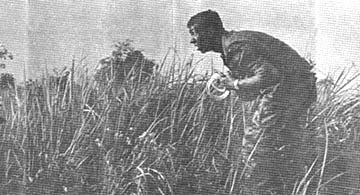 |
 |
ON THE HORN – Staff Sergeant Richard E. Reader establishes radio contact with choppers as Specialist 4 Lester Rhodes keeps a watch before moving to the pickup zone. |
| REPORTING – Sergeant Thomas B. Besser pokes his head out of a tunnel to give a situation report to First Lieutenant Arthur J. Tomascheck, LRP team leader. | 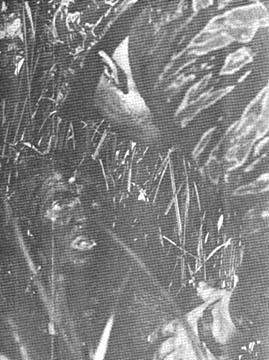 |
Page 5 TROPIC LIGHTNING NEWS February 10, 1969
| WOUNDED HUEY – Within minutes an airlifted 25th Division rigging team scrambles over the crippled helicopter, preparing it for pickup-up by Chinook. | 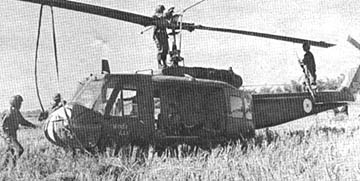 |
Chopper Abandons Eagle
Flight
Chinook Tows to Camp Garage
CU CHI - Some of the men of Alpha
Company, 2d Battalion, 12th Infantry, were delayed recently during an Eagle
Flight mission.
The Huey helicopter carrying the Tropic Lightning soldiers
experienced a rare turbine malfunction and was forced to leave the ten-ship
formation and set down in an available clearing.
Pilot of the chopper, Warrant Officer Lance L. Blair of San
Francisco, experienced a loss of power. Since his craft was fully loaded
he had to find a place to land quickly.
The chopper was brought down gently by Blair in a clearing near
Fire Support Base Pershing north of Cu Chi.
Air Mission Commander Captain James Cunningham of Chico, Calif.,
said that gunships were inserted in the area to give cover while a Chinook
carried the injured Huey back to Cu Chi base camp.
“Recovery operations were underway before the ship touched
down,” he stated. Cunningham added, “Blair did a great job landing the
chopper under hazardous conditions.”
|
Story, Photos By SP4 Charles Haughey |
| A TROPIC LIGHTNING infantryman from the Fire Brigade’s 2d Battalion, 12th Infantry (above) watches as Smokey provides concealment for the downed chopper. Rice straw (below left) flies as a rigger secures the harnessed Huey. Draped with straw (below right) the pilotless craft is ‘towed’ to a Cu Chi ‘garage’ for an overhaul. |  |
 |
 |
Page 6 TROPIC LIGHTNING NEWS February 10, 1969
A Brother Replaces A
Brother
Same Unit, Same Company
TAY NINH - “Hello brother.”
That was part of the conversation between Sergeant Bill R. Roberts
and Private First Class Charles A. Roberts at Company A, 4th Battalion
(Mechanized), 23d Infantry.
Charles just arrived at the 25th Division and was assigned to
his brother’s unit just a few days before Bill left the Army to return to
their home town of Gilbert, W. Va.
The young rifleman was very startled when he discovered his new
assignment. “Was I surprised when I learned that I was going to replace
my brother in Vietnam,” commented the new Roberts.
Taking this opportunity to catch up on the latest news from home,
the older Roberts spent his last few days in country with his brother discussing
the home front.
“This is a very rare occurrence in Vietnam,” said Sergeant
First Class Daniel W. Ward, of Coral Gables, Fla. Ward who is the
personnel section non-commissioned officer for the 4th of the 23d said that as
long as he has been in Vietnam he has never seen or heard of a coincidence such
as this. “The odds of getting the same assignment as a friend, let alone
a brother, are very slim,” added Ward.
 |
HELLO, BROTHER – Sergeant Bill R. Roberts (right) greets his brother Private First Class Charles A. Roberts upon his arrival at Company A, 4th Battalion, (Mechanized) 23d Infantry. The sergeant had only a few days to chat with his brother before leaving the Army to return to his hometown of Gilbert, W. Va. (PHOTO BY SP4 ROGER WELT) |
Bob Hope Heaps Praise On All
Who Serve Here
Editor’s note – the following story, written by Bob Hope, upon his
arrival in Bangkok, Thailand, summarizes his views on Vietnam and some of the
experiences he had on this most recent stage tour.
By Bob Hope
BANGKOK: Last night our blacked-out choppers
lifted off the pads at Cu Chi, Vietnam, and we saw the jungle fires burning not
more than a half-mile away and heard the bombardment of artillery. It
struck me that within hours we’d be starting back to the world, but that the
15,000 or so youngsters of the 25th Infantry Division, for whom we’d just
played, would be remaining in that steaming insect-infested jungle to fight a
vicious elusive enemy.
I thought of some of the young guys we’d met. The River
Rats of Dong Tam, the Dust-Offs at Cu Chi, the Jolly Greens and the Sandys at
Nakhon Panom, Thailand and the Marines at Da Nang and Chu Lai, the fighter
pilots on the USS Hancock, the gunners on the New Jersey and the hundreds of
kids in the hospitals for whom the war is over.
They all lay their lives on the line every day. You can’t
ask for more. I don’t care how many times you’ve seen the war on
television or read about it in your newspapers. You can’t have any idea
of what it’s really all about until you’ve felt the heat, tasted the dust or
sloshed through the mud and sensed the menace behind every clump of trees or
innocent-looking jungle foliage.
These are the facts of life for 500,000 of our finest young men in
this the most frustrating of all wars. I can tell you that they’re all
meeting this challenge with fantastic courage, resourcefulness and good humor.
While at the Paris peace talks they bicker endlessly about the shape of the
table, the guys in Vietnam are preoccupied with the more practical problems.
Whether the harmless-looking shack they’re about to enter is booby-trapped,
whether the mosquito that just bit them carries malaria, whether they will
survive the day.
As one GI put it, “every morning when I get up I feel I’m
ahead.” Right there under these conditions why is it that moral is so
high?
Our project officer Colonel “Red” Beasley, explained it this
way. “These young men believe in what they’re doing.” He said,
“they know that they’re providing protection for fellow human beings who are
being subjected to the grossest Communist techniques of persuasion and terror.
Like many of us, although they don’t completely comprehend the political and
economic complexities involved in this conflict, they feel instinctively that
what they are doing is humane and right. To that, I say, ‘Amen’.”
I would just like to add that these are the men who truly represent
the non-generation in contrast to the over-publicized, noisy dissenters and
rioters in our colleges and out. They manifest the strength, the humanity
and the clear-thinking that our country will need in the future. I can
assure the parents that we can put our trust in this generation of Americans.
Even to the old hands, this has been a memorable tour. For
the youngsters, the Golddiggers and the Honeys, limited to ages 18 to 22, it has
not only been a real education but an experience in giving. They spent
every minute off stage at every base, talking, joking, sympathizing with every
serviceman within reach.
Between them and the soldiers there was a perfect understanding,
perhaps more than that, a kind of love. The kids really came of age.
This was a tough trip. The flu bug felled many from writers
to stagehands to performers, but despite illness, fatigue and traveling under
the most arduous conditions, every show went on right on schedule. We just
couldn’t disappoint them and the enthusiasm and the gratitude with which we
were received made it all worthwhile.
At every show, a kind of affection from the audience was
reciprocated from the stage. It was the sort of audience-performer empathy
you don’t find on television or in theatres or nightclubs anywhere in the
states. It was show-business at its finest.
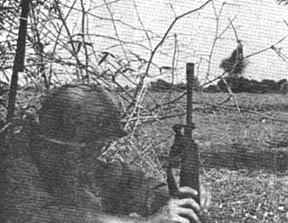 |
OBSERVING ARTILLERY – A 2d Battalion, 27th Infantry RTO watches artillery pound enemy positions near the 2d Brigade’s Fire Support Base Reed. (PHOTO BY SP4 R. B. WILLIAMS) |
Clan Fires 500,000th
CU CHI - The 500,000th round fired by
the 3d Battalion, 13th Artillery recently sped down the tube bringing its
awesome thunder home to the enemy.
The round was fired by a D Battery 8-inch howitzer at ceremonies
near Tay Ninh and represented the nearly 58 million pounds of steel and
explosives delivered against the enemy by the medium-heavy artillery battalion.
Since deployment from the shores of Hawaii in April of 1966 The
Clan has been involved in some of the heaviest fighting in the Division’s
area. Possessing the long-range howitzers of the division, The Clan has
also unleashed its tremendous firepower in close-in fighting, at times leveling
its howitzers to repel the on-charging enemy.
During the ceremonies, Major General Ellis W. Williamson, division
commander, urged the men of The Clan to continue their fine fire support for the
Tropic Lightning Division.
Page 7 TROPIC LIGHTNING NEWS February 10, 1969
 |
EARTH MOVER - Specialist 4 Leonard F. Cuprise of Degerton, Wisc, assigned to the 588th Engineer Battalion operates a D-7 bulldozer, clearing brush and forming berms at Tropic Lightning’s Fire Support Base Stoneman, 15 miles southeast of Tay Ninh Base Camp. |
Mobility Key For Manchus,
Arty
TAY NINH – “The Infantry’s
ability to keep after the enemy is a vital factor in the success of ground
operations throughout the Republic of Vietnam. Mobility, whether on water,
land or in the air is the greatest single advantage we have over the enemy,”
stated Lieutenant Colonel Leo L. Wilson, commander of the 4th Battalion, 9th
Infantry.
Mobility was the key when First Support Base Austin, 22 miles
southeast of Tay Ninh base camp, was leveled and Fire Support Base Stoneman
seven miles away was established.
Time was important. More than 100 tons of materials had to be
moved. On the morning of the move, hours before dawn the Delta Company
Manchus and B Battery, 3d Battalion, 13th Artillery, were busy readying their
gear, taking in wire, emptying sandbags, and stacking equipment.
With the first light of morning these materials were loaded on more
than 40 two-and-one-half ton trucks for the big move. Timbers, steel
plating engineer stakes, every piece of Army equipment down to the last sandbag
was loaded on the trucks to be hauled to the new camp.
Meanwhile, bulldozers, road plows and men from Alpha Company, 65th
Engineer Battalion, and Headquarters Company of the 588th Engineer Battalion
worked at both sites clearing brush and forming berms at Fire Support Base
Stoneman, as well as filling trenches and leveling the site at FSB Austin.
By ten o’clock, with the area secured and several fortified
positions nearing completion, five self-propelled 155mm Howitzers from B
Battery, 3d Battalion, 13th Artillery, came grinding into their positions.
The positions had been selected that morning by the 7th Battalion, 11th
Artillery, executive officer Major Gerald D. Curbow of Hollister, Mo., and 4th
Battalion, 9th Infantry, battalion commander Lieutenant Colonel Leo L. Wilson of
Salina Kans.
During the entire day, the operation continued like clockwork.
That evening Fire Support Base Stoneman was all but complete. All
personnel had overhead cover; six strands of concertina wire had been laid and
reinforced with engineer stakes. An interlocking trench system had been
dug connecting fighting positions and bunkers around the perimeter. Most
important to the hungry infantry and artillery men were the two mess halls that
had been put into operation. Hot chow was ready to be served.
|
Story, Photos By SP4 H. J. Tschirner |
| RUMBLING IN – A self-propelled 155mm Howitzer from B Battery, 3d Battalion, 13th Artillery grinds into position at Tropic Lightning’s new fire base Stoneman. | 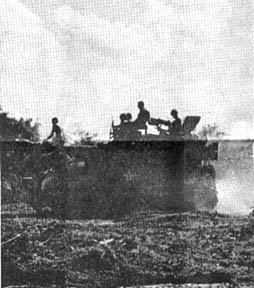 |
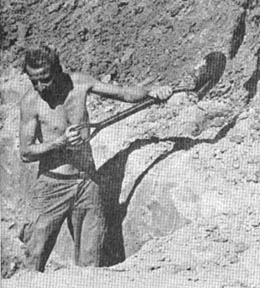 |
HE DIGS IT – Private First Class Robert J. Kalainwell of Clarksville, Iowa, works diligently to complete his fighting position and bunker. |
| LAYING IN #5 GUN – A self-propelled Howitzer has been moved into position. Staff Sergeant Ronald G. Bargre of Lawton, Okla., and Sergeant Charles J. Tucker of Forrester, Iowa, both assigned to D Battery, 3d Battalion, 13th Artillery, use an aiming circle to get each howitzer set on the proper direction. | 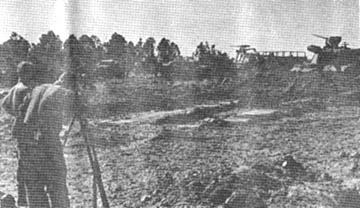 |
Page 8 TROPIC LIGHTNING NEWS February 10, 1969
Medal Of Honor Awarded To
25th Division Platoon Leader
A U.S. Army infantry platoon leader has been awarded the Medal of
Honor posthumously for giving his life to shield two wounded soldiers from an
exploding grenade.
The medal recognized the heroism of First Lieutenant Stephen E.
Karopczyc, who became the 41st Army member to receive the nation’s highest
combat award for service in Vietnam.
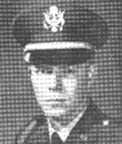 Secretary of the Army Stanly R. Resor presented the award to
Lieutenant Karopczyc’s parents, Mr. and Mrs. Edward J. Karopczyc of Bethpage,
N.Y. in a ceremony at the Pentagon.
Secretary of the Army Stanly R. Resor presented the award to
Lieutenant Karopczyc’s parents, Mr. and Mrs. Edward J. Karopczyc of Bethpage,
N.Y. in a ceremony at the Pentagon.
Karopczyc was leading the 3d Platoon, A Company, 2d Battalion, 35th
Infantry, during a flanking maneuver against an enemy force on March 12,1967.
Although severely wounded, he directed the operations of his
platoon during several hours of heavy fighting. When a grenade was hurled
close to Karopczyc and two other wounded men, the officer left his protected
position to cover the grenade with a steel helmet and protect the other men.
The grenade exploded, driving fragments into Karopczyc’s legs,
but his action prevented further injury to the other men. He succumbed to
his multiple wounds two hours later.
At the Medal of Honor ceremony, Secretary Resor said, “The hard
fighting in Vietnam has taught us again the wonderful qualities of the young
American soldier - his sheer courage, his deep dedication to his fellow men and
his high sense of duty.
“But even in this honored company, Lieutenant Karopczyc stands
out. Few can appreciate or comprehend the inner spirit which inspired him.
We do not ever in our lifetime face such a test of demonstrating our complete
and total devotion to our friends. Lieutenant Karopczyc faced this test
and was not found wanting.” (ANF)
Triple Deuce….
(Continued From Page 1)
opening up from Fire Support Bases Rawlins, Stoneman and Wood and from Dau Tieng
base camp began pounding the enemy positions. Almost 2,500 rounds pocked
the ambush site and its approaches.
Joining in the fusillade were Alpha and Bravo Batteries, 1st
Battalion, 27th Artillery, Bravo Battery, 2d Battalion, 13th Artillery; Charlie
Battery, 2d Battalion, 32d Artillery, and Alpha Battery, 2d Battalion, 77th
Artillery.
Lieutenant Colonel Vernon Lewis of Marshall, Tex., commander of the
Up Tight 2d of the 77th Artillery, was flying overhead in a light observation
helicopter and coordinating fire from the five batteries.
“I moved Alpha Battery out of Fire Support Base Wood and into a
position several miles up the road, giving us more punch in the area,” noted
Lewis. He praised the accuracy of all the fire support.
Lewis also spotted a force of about 30 enemy racing toward a
woodline and directed gunships onto the spot.
Meanwhile Air Force F100 Supersabre jets flashed overhead dropping
bombs on the enemy, guided by Major William I. Holland o f Raleigh N.C., forward
air controller with the 3d Brigade.
The ambush attempt ended in a shambles as 115 enemy lay dead near
the site. The Dau Tieng convoy moved on to its destination. But the
enemy was not yet through.
From a second hideout in the Cau Khoi Rubber Plantation, another
ambush opened up on a convoy returning to Cu Chi from Tay Ninh.
This enemy force was estimated as one rifle company plus elements
of a company of heavy weapons, mainly .51 caliber machineguns.
Earlier in the day, Bravo Company of the Triple Deuce received
small arms fire in the area but escorted the northbound convoy through without
incident.
On the return to Cu Chi, however, the enemy opened up with rifles,
machineguns and RPG rocket grenades. Armored personnel carriers of Bravo
and Charlie Companies of the Triple Deuce charged into the battle, disrupting
the enemy ambush and killing seven.
As the remaining enemy fled about 30 raced across a clearing to the
south. They were spotted by the command and control helicopter of Colonel
Louis J. Schelter Jr., 3d Brigade commander, from Columbus, Ga.
“The door gunners, the brigade commander and myself opened up
with everything we had,” related Command Sergeant Major Howard Brosseau of
Highlands Falls, N.Y. “We were shooting with about as much firepower as
a gunship.”
The colonel fired more than 1,000 rounds from his CAR-15 personal
weapon as those aboard the ship blasted away.
Several of the enemy fell in their tracks as the chopper, under
direction of Warrant Officer 1 Gunther Siedler of Torrington, Wyo., the aircraft
commander, maneuvered down at the enemy force.
“The whole crew and especially Mr. Siedler did a magnificent
job,” commented Brosseau.
Witnesses on the ground said that those aboard the colonel’s ship
probably kept four trucks from being overrun as an enemy force advanced.
Captain Jon Swift of Plattsburg, N.Y., another Tropic Lightning
forward air controller brought five flights of F-100s, A37s and F46s onto enemy
positions.
Because of darkness, they were unable to make a complete sweep of
the Cau Khoi battleground.
Cav Kills 20 Enemy, Finds
Ammunition, Rice And Bikes
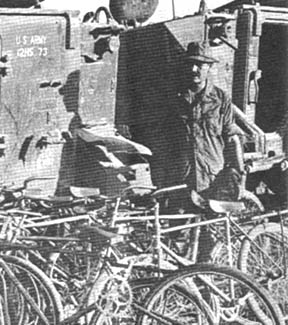 DAU TIENG - In a week of heavy contact
with the enemy elements recently, the 3d Squadron, 4th Cavalry killed 20 enemy
and detained two suspects.
DAU TIENG - In a week of heavy contact
with the enemy elements recently, the 3d Squadron, 4th Cavalry killed 20 enemy
and detained two suspects.
The Cav destroyed a number of bunkers and tunnel complexes and
captured over 45,000 pounds of rice plus several AK-47s, RPG launchers, assorted
hand grenades and mines. Bravo Troop also found themselves the new
possessors of 17 bicycles.
The action took place west of the Saigon River, between the Ho Bo
and Boi Loi Woods, about 10 miles south of Dau Tieng during an operation
nicknamed Toadstool.
In one day alone, Bravo Troop destroyed 207 enemy bunkers.
Some of them had walls four feet thick and were reinforced with sandbags and
steel plating. Some women’s clothing was found in one bunker.
During one day of heavy action which six NVA were killed, the Cav
troopers uncovered a field hospital consisting of five bunkers.
Inside was an operating table, bottles of penicillin and bandages.
Dried blood on the ground indicated that it had been used recently. Off to
one side were bunkers apparently used as nurse’s quarters.
The horsemen destroyed a command bunker with tunnels leading to
fighting positions. Nearby they located a cache containing 11,000 pounds
of salt and 1200 pairs of white plastic sandals. Several bicycles were
found outside tunnels, beside rice caches and other such places. Some of
them were run over by the tanks.
And what is to be done with these bicycles now? Command
Sergeant Major Wilbur Duggins of the three-quarter Cav, plans to have them
painted red and white, the colors of the Cav, and let his troopers use them when
they are in from the field and want to go to the PX, the Service Club or when
they are out-processing and need transportation.
After all, a cavalryman never walks. He rides.
Division Man In VN Holds
County Office
By 1Lt. Mack D. Gooding
TAY NINH - Captain Shigeto Murayama of
Kahului, Maui, Hawaii was elected county treasurer of Kahului, but he is
finishing his term of office while serving as the assistant intelligence officer
of the 1st Brigade.
Murayama, who campaigned under the nickname Mustard held his office
when he was called to active duty with the 29th Brigade last May.
The deputy treasurer of Kahului has taken over the duties of
treasurer. Murayama’s term expired in December.
Asked if the job will still be waiting for him when he returns from
Vietnam, the captain explained, “Not in the true sense of the word, since the
voters decided to establish a charter form of government that combines the
treasurer’s office and several other offices into one Department of Finance,
with the director of finance appointed by the mayor.
“However, before I came to Vietnam I learned that mayor elect
Elmer F. Cravalho had appointed me finance director.”
Murayama explained that he could have been deferred from coming to
Vietnam since he was an elected official.
“However, I’ve been in the Reserve program for 20 years, and
during that time the Army has spent a lot of money to send me to various
schools, and I felt it was my obligation to give the Army some return for its
money.”
Thanks to
Mack D. Gooding, 15th PID, 1st Bde., for sharing this issue,
Kirk Ramsey, 2nd Bn., 14th Inf. for creating this page.
This page last modified 8-12-2004
©2004 25th Infantry Division Association. All rights reserved.